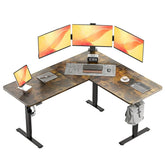Are Long Hours in Your Audio Engineering Studio Taking a Toll? Discover a Potential Solution.
If you're an audio engineer, you know the drill. Hours melt away as you meticulously sculpt sound, diagnose audio issues, and ensure every frequency sits perfectly in the mix. Your focus is laser-sharp, your ears are trained to the finest detail, and your passion for crafting exceptional audio drives you. But amidst this intense concentration, there's a silent and often overlooked challenge: the physical strain of prolonged sitting.
Think about it. How many hours each day do you spend hunched over your console or DAW, making critical adjustments, monitoring levels, and refining sonic textures? Whether you're tracking live performances, deep in post-production, or mastering the final cut, the demands of audio engineering often keep you glued to your chair for extended periods. And while your mind is deeply engaged in the art of audio engineering, your body is often paying a hidden price.
The discomfort might start subtly – a slight stiffness in your back, a tightness in your shoulders. But over time, these minor aches can escalate into chronic pain, impacting not only your physical well-being but also your ability to fully concentrate on the nuances of audio. Many audio engineers experience lower back pain, neck strain, and even issues with circulation due to the static nature of their work environment.
The irony is that the very dedication required for exceptional audio engineering can lead to habits that compromise your physical health. Taking breaks can feel disruptive to the creative flow, and the pressure to meet deadlines often pushes movement to the bottom of the priority list. But what if there was a way to introduce more movement and flexibility into your audio engineering workflow without sacrificing focus or productivity?
Enter the standing desk. Once primarily associated with general office environments, the standing desk is gaining traction in creative fields like audio engineering, and for compelling reasons. A standing desk offers a simple yet powerful solution to combat the negative effects of prolonged sitting. By providing the option to alternate between sitting and standing, a standing desk can help audio engineers address the physical challenges inherent in their profession.
Understanding the Impact of Prolonged Sitting on Audio Engineers
For professionals in audio engineering, the consequences of spending too many hours seated can be significant:
-
Back and Neck Pain: Maintaining a fixed posture for extended periods puts undue stress on the spine and neck muscles, common complaints among audio engineers.
-
Reduced Circulation: Sitting for long durations can restrict blood flow, leading to fatigue and potentially more serious health issues down the line for dedicated audio engineers.
-
Energy Slumps: The lack of movement can contribute to decreased energy levels, making those critical late-night audio sessions even more challenging.
-
Compromised Posture: Slouching while working on intricate audio details can lead to poor posture, impacting breathing and overall physical health for the audio engineer.

These physical discomforts can directly impact an audio engineer's ability to perform at their best. Fatigue can cloud judgment, pain can be distracting, and a lack of energy can hinder the creative process that is so vital in audio engineering.
Introducing the Standing Desk: A New Perspective for Audio Engineers
The core concept of a standing desk is simple: it's a workstation that allows you to work comfortably while standing. However, modern standing desks often offer height adjustability, providing the flexibility to switch between sitting and standing as needed. For audio engineers, this adaptability can be a game-changer.
Imagine being able to stand while tracking a live instrument, allowing for more natural movement and potentially better communication with the performers. Or picture yourself standing during the initial stages of mixing, gaining a different spatial perspective on the sonic landscape. Even the simple act of transitioning from sitting to standing can provide a mental and physical refresh, allowing you to approach your audio work with renewed focus.
A quality standing desk designed for the demands of a modern studio can offer numerous potential benefits for audio engineers:
-
Potential Relief from Back and Neck Pain: By allowing for more movement and better posture, a standing desk can help alleviate the chronic pain that many audio engineers experience.
-
Improved Energy Levels and Circulation: Standing promotes better blood flow, which can lead to increased energy and reduced fatigue during long audio sessions.
-
A Fresh Sonic Perspective: Changing your physical position can offer a new way to listen to your audio, potentially revealing subtle mix issues or inspiring new creative directions.
-
Enhanced Collaboration: In a shared studio environment, a standing desk can facilitate more natural interaction with clients and collaborators.

Is a Standing Desk Right for Your Audio Engineering Studio?
If you're an audio engineer who is concerned about the physical demands of your profession or simply looking for ways to optimize your studio environment, a standing desk is definitely worth exploring. It's a tool that has the potential to enhance your comfort, productivity, and long-term well-being, ultimately allowing you to focus more fully on the art and science of audio engineering.
Curious to learn more about how a standing desk could integrate into your audio engineering workflow and the different options available?
Investing in your studio should include investing in your health and comfort. A standing desk could be the key to a more sustainable and enjoyable career in audio engineering.



